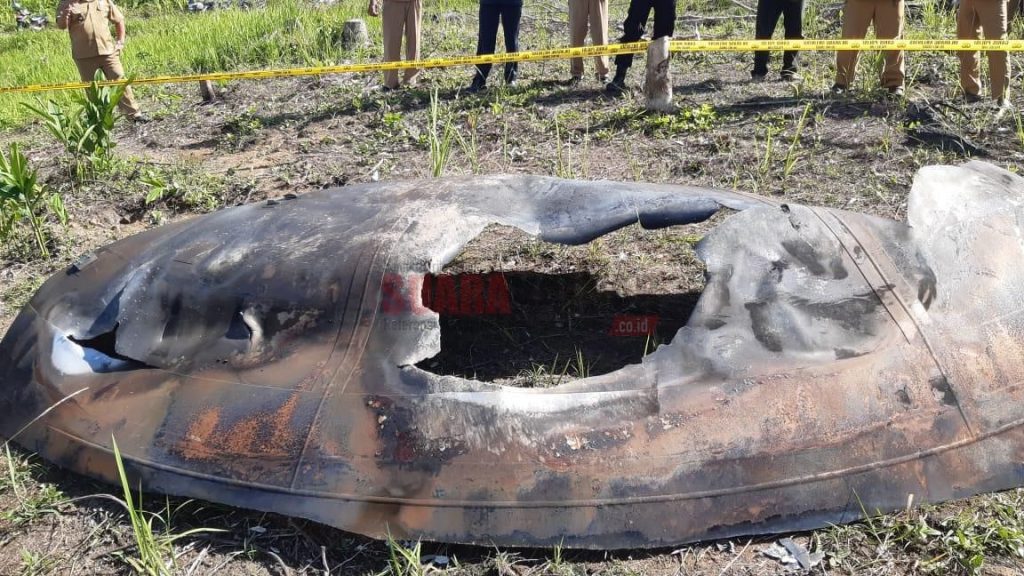Following recent sightings of the China’s Long March 5B rocket re-entry over East Malaysia during the weekend, there are now reports of debris spotted on the ground in Sarawak and West Kalimantan in Indonesia. There are no reports of injuries so far but residents are warned not to go near the affected areas due to radiation concerns.
As reported by The Borneo Post, metal fragments embedded one metre deep in the soil was found in a compound of a house in Batu Niah, Sarawak. The resident contacted the police and a report was made yesterday at 5.30pm. Since the police couldn’t identify the object, they have asked for help from the Hazmat team of the Fire and Rescue Department (Bomba) and the Ministry of Science, Technology and Innovation (MOSTI). Two families were told to vacate their homes due to radioactivity concerns.
Diduga serpihan roket yg jatuh ke bumi, di Kabupaten Sanggau, Kalimantan Barat. Masih menunggu konfirmasi resmi dari pihak yang berwewenang. pic.twitter.com/eW3wNPC0gE
— $ony Rcd (@sonyhas_i) August 1, 2022
Moving down south, more debris were found near the Indonesia-Malaysia border. Residents in Sekayam District, Sanggau Regency in West Kalimantan, have spotted fragments of foreign objects around an oil palm plantation that are believed to be from the Long March 5B rocket. A local resident said there were rumbling sounds on Saturday night and the next day, he found what appears to be rocket fragments on his land.

The large debris is said to be 5 metres long and 2 metres wide. The Sanggau police have cordoned off the site and has urged the public not to approach the location fearing that it could be radioactive.
Malaysia’s Science, Technology and Innovation Minister Dr Adham Baba said his ministry has dispatched a team to investigate the debris in Niah, Sarawak. The team consists of Malaysian Space Agency (MYSA) and Atomic Energy Licensing Board (LPTA), who will be working closely with the Miri Police. Dr Adham said his ministry will release a report soon and he urged the public to stay calm and not to disrupt the investigation.
As confirmed by MOSTI recently, debris from China’s Long March 5B had re-entered earth’s atmosphere at 00:55am on 31st July 2022 at 9°N 119°E around the Sulu Sea. They added that the burning debris have crossed the Malaysian airspace and it was detected at several locations in Sarawak.
The People’s Republic of China did not share specific trajectory information as their Long March 5B rocket fell back to Earth.
— Bill Nelson (@SenBillNelson) July 30, 2022
All spacefaring nations should follow established best practices, and do their part to share this type of information in advance to allow…
China has been criticised for not sharing specific trajectory information for its uncontrolled reentry of its Long March 5B rocket. According to National Aeronautics and Space Administration (NASA) administrator Bill Nelson, all spacefaring nations should follow established best practices and do their part to share information in advance to allow reliable predictions of potential debris impact risk especially for heavy-lift vehicles like the Long March 5B which carries a significant risk of loss of life and property.
According to SCMP, China has dismissed Western concerns over the debris, calling it a smear effort as the US-China space race escalates. Shanghai-based website Guancha.cn said “The US and Western media deliberately exaggerate and exaggerate the ‘loss-of-control’ of the Chinese rocket debris and the probability of personal injury caused by the rocket debris, obviously with bad intentions.”
This isn’t the first time China’s rocket launches have left debris on earth. Several metal objects were found in a village in India back in April and are believed to be from the Long March 3B rocket launched in February 2021.








